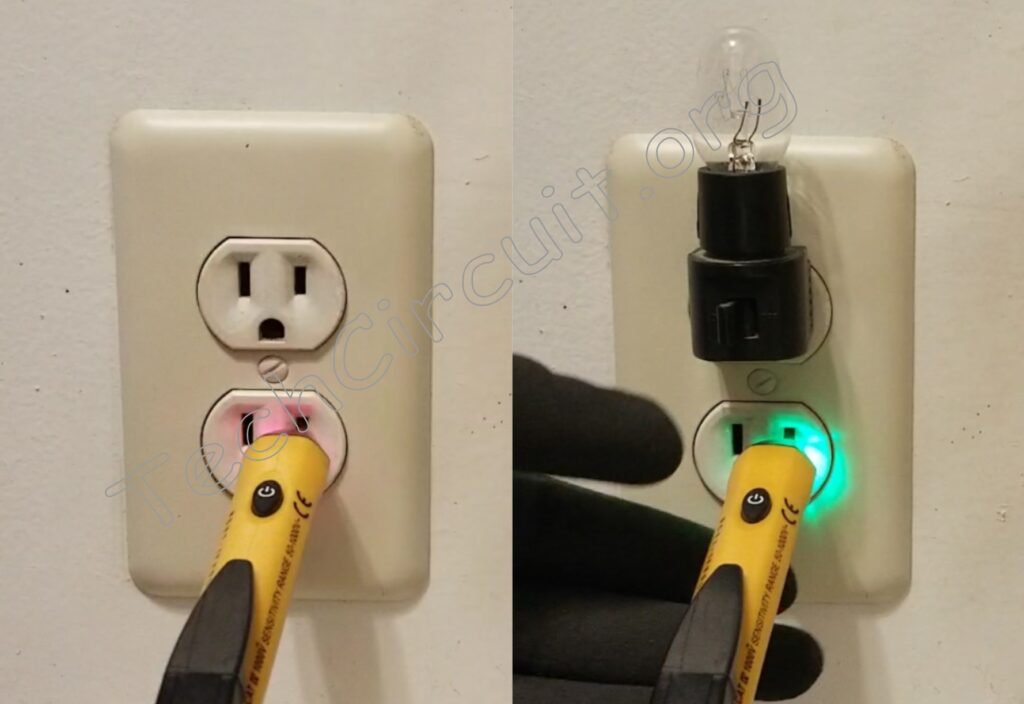Introduction
This blog will introduce the many ways that an NCV voltage pen can be used to diagnose electrical circuits. In fact, you might be surprised as to how versatile and useful the voltage pen can actually be. I’ll show you how this simple device can be used to detect Ghost Voltages, detect Compromised Voltage Supplies (like a residential outlet that fails under load), detect a Loose or Open Neutral, and even perform advanced minimally-invasive Point-to-Point 120v Circuit Diagnostics (such as with a refrigerator defrost system).

THIS BLOG IS INTENDED FOR APPLIANCE TECHNICIANS ONLY. ALWAYS USE APPROPRIATE SAFETY PRECAUTIONS WHEN WORKING WITH ELECTRICITY. For informational purposes only. If you choose to utilize the concepts in this blog, you do so at your own risk.
The voltage pen referenced in this blog is manufactured by Klein, as pictured below. It has a trigger threshold voltage of 50 volts. It can be purchased by clicking the image.

How does an NCV Voltage Pen Work?
The NCV voltage pen works by detecting the charge associated with an energized circuit that is a certain voltage above ground level. The person holding the voltage pen (you), is the reference point, and is assumed to be at “ground potential”, or 0 volts with respect to ground. To accomplish this task, the pen is capacitively coupled to you when you are holding it. Any detection of an AC voltage above the threshold (50 volts for the Klein pen referenced in this article), will cause the pen to “signal” red with an audible tone.
How to use the Voltage Pen
Below, I’ll describe the many useful ways that a voltage pen can be utilized in your diagnostics.
Detect the Presence of Line Voltage
The most very basic function of the voltage pen, is to detect the presence of line voltage. In North America, line voltage, or the “hot line” is generally 120 volts with respect to ground (and neutral). While holding the Klein voltage pen, it will signal and turn red when it detects the presence of line voltage.

Detect Ghost Voltages
Ghost voltages typically appear as a result of capacitive or inductive coupling via proximity to other wiring. An example is an unused wire in a Romex bundle that builds up a charge on it because it is next to the hot wire in that bundle. That charge has little ability to supply any current, but can still read a voltage when tested with a multimeter or with your voltage pen. When any kind of load is placed on the conductor suspected of processing a ghost voltage, that voltage often disappears. A voltage pen can be used to monitor the state of that conductor during this process, with virtually no effect on the ghost voltage. Thus a voltage pen’s ability to monitor ghost voltages is dependent on one’s secondary ability to load down the conductor of interest.
Detect a Compromised Hot
A compromised voltage supply (like with a 120v outlet) is one that may test OK with a standard multimeter but fail under load. This just means that there may be a loose upstream connection on the “hot” line. In many cases, a multimeter isn’t needed in order to determine that such a compromised state exists. Often, one only needs to test the hot side of the outlet with a voltage pen for a signal. If the outlet has a loose upstream connection, it will still signal with the voltage pen when not under load as shown below. However, when the load is plugged back into the outlet, the voltage pen stops signaling – indicating that the “hot” line has “dropped out” under load. If the voltage pen didn’t even signal when not under load, “hot” may actually be disconnected from the outlet altogether (or the breaker off).

Detect a Loose or Open Neutral
Detecting a loose or open neutral with a voltage pen is done in a similar manner as detecting a loose hot line as above. However a loose neutral will typically rise toward the level of hot when placed under load. As such, the an outlet may cause the voltage pen not to signal at all when their load is placed on it, i.e. the outlet may test just fine with a multimeter or even a voltage tester until placed under load. However once you place the load on the outlet voltage that neutral tends to rise – approaching the level of “hot” – causing the voltage pen to signal. This is a clear indication of a loose upstream neutral. This neutral test can also be done for 240v split-phase supplies. More about detecting loose neutrals with a voltage pen in this article here: https://techcircuit.org/finding-an-open-neutral-with-a-voltage-pen/

Point-to-Point Diagnostics
Point to point diagnostics can be done with a voltage pen by checking along a circuit at available test points and noting voltage differences. This method is performed in a binary manner by noting whether the voltage pen either signals or not. A signal means 120 volts whereas no signal means 0 volts (or Neutral). Tracing a circuit in this way when a load is not properly operating allows you to map out the voltage states along that circuit path. Using this information, you can readily tell where the break in the circuit is by determining the point at which the voltage state changes.
Knowing that it is virtually impossible to have 120v across a closed circuit or across a load (without the load either functioning or being in a failure state) unlocks a plethora of diagnostic opportunities that don’t require cutting of wires, exposing of conductors, or referencing common points with a multimeter. A minimally invasive application of this method to trace a refrigerator defrost system is depicted below to show that the defrost heater is in fact energized and must have failed if it is not getting hot.

Here is a point-to-point diagnostic guideline for use with a voltage pen.

For more information on voltage pen point to point diagnostics, please see this article: https://techcircuit.org/120v-point-to-point-voltage-pen-troubleshooting-cheat-sheet/
A RECOMMENDED NCV VOLTAGE PEN CAN BE PURCHASED HERE.
Summary
The NCV, or “non-contact voltage” pen is largely underutilized by field technicians because the breadth of its diagnostic value is underrated and often not understood. It is most often simply used to detect the presence of hot, which it can readily do. However it can also readily detect compromised voltage sources, loose neutrals, and allow field technicians to map out a circuit of interest by noting the binary states of the voltage pattern when tested at sequential points along that circuit path. Using a voltage pen, one can readily determine open points in circuits without cutting any wires, exposing conductors, or doing any static testing. This can vastly improve your diagnostic capabilities, speed, and efficiency in the field.
Don’t forget:
“Diverting 10 min/day of social media time towards learning something new, is 5 hours of newfound monthly knowledge.” – SM
To DONATE to the Tech Circuit – CLICK HERE
Alphabetical Links to all Tech Circuit Articles and Blogs – CLICK HERE
Links to all Tech Circuit Cheat Sheets/Field References for Appliance/HVAC Techs – CLICK HERE
For additional electrical and electronics learning material for field techs, visit the following links:
Homepage at http://www.TechCircuit.org
Facebook group at:
https://www.facebook.com/groups/746823709133603
Youtube Channel: https://www.youtube.com/@TheTechCircuit
We are a participant in the Amazon Services LLC Associates Program, an affiliate advertising program designed to provide a means for us to earn fees by linking to Amazon.com and affiliated sites.
